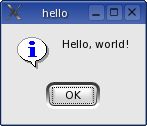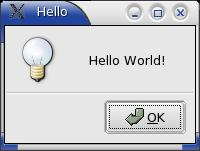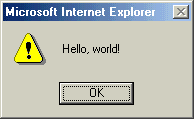Hello world program
From Wikipedia, the free encyclopedia.
A "hello world" program is a computer program that simply prints out "Hello, world!" on a display device. It is used in many introductory tutorials for teaching a programming language and many students use it as their first programming experience in a language.
Such a program is typically one of the simpler programs possible in a computer language. Some are surprisingly complex, especially in some graphical user interface (GUI) contexts. Some others are surprisingly simple, especially those which rely heavily on a particular command line interpreter ("shell") to perform the actual output. In many embedded systems, the text may be sent to a one or two-line LCD display (and in yet other systems, a simple LED being turned on may substitute for "Hello world!").
A "hello world" program can be a useful sanity test to make sure that a language's compiler, development environment, and run-time environment are correctly installed. Configuring a complete programming toolchain from scratch to the point where even trivial programs can be compiled and run may involve substantial amounts of work. For this reason, a simple program is used first when testing a new tool chain.
While small test programs existed since the development of programmable computers, the tradition of using the phrase "Hello, world!" as the test message was influenced by an example
program in the book The C
Programming Language, by Brian Kernighan and Dennis Ritchie. The example program from that book prints "hello,
world" (i.e., no capital letters, no exclamation sign; those have entered the tradition later). However, the first known
instance of the usage of "Hello world!" is in A Tutorial Introduction to the Language B, by Brian Kernighan. [1] (http://cm.bell-labs.com/cm/cs/who/dmr/bintro.html)
A collection of "hello world" programs written in various computer languages can serve as a very simple "Rosetta Stone" to assist in learning and comparing the languages. Keep in mind, however, that unless assembly language or similar very low-level (hardware-near) languages are involved, not much "computing" in the way of actual calculation, is usually exhibited.
Here are some examples in different languages:
Text user interface (TUI) (aka console, line-oriented)
ABC
WRITE "Hello World"
Ada
with Ada.Text_Io;
procedure Hello is
begin
Ada.Text_Io.Put_Line ("Hello, world!");
end Hello;
AmigaE
PROC main()
WriteF('Hello, World!')
ENDPROC
APL
'Hello World'
Assembly language
Accumulator-only architecture: DEC PDP-8, PAL-III assembler
See the example section of the PDP-8 article.
First successful ÁP/OS combinations: Intel 8080/Zilog Z80, CP/M, RMAC assembler
bdos equ 0005H ; BDOS entry point
start: mvi c,9 ; BDOS function: output string
lxi d,msg$ ; address of msg
call bdos
ret ; return to CCP
msg$: db 'Hello, world!$'
end start
Accumulator + index register machine: MOS Technology 6502, CBM KERNAL, ca65 assembler
MSG: .ASCIIZ "Hello, world!"
LDX #0
LDA MSG,X ; load initial char
@LP: JSR $FFD2 ; chrout
INX
LDA MSG,X
BNE @LP
RTS
Accumulator/Index microcoded machine: Data General Nova, RDOS
See the example section of the Nova article.
Expanded accumulator machine: Intel x86, MS-DOS, TASM
MODEL SMALL
IDEAL
STACK 100H
DATASEG
MSG DB 'Hello, world!$'
CODESEG
MOV AX, @data
MOV DS, AX
MOV DX, OFFSET MSG
MOV AH, 09H ; DOS: output ASCII$ string
INT 21H
MOV AX, 4C00H
INT 21H
END
General-purpose fictional computer: MIX, MIXAL
TERM EQU 19 console device no. (19 = typewriter)
ORIG 1000 start address
START OUT MSG(TERM) output data at address MSG
HLT halt execution
MSG ALF "HELLO"
ALF " WORL"
ALF "D "
END START end of program
General-purpose-register CISC: DEC PDP-11, RT-11, MACRO-11
.MCALL .REGDEF,.TTYOUT,.EXIT
.REGDEF
HELLO: MOV #MSG,R1
MOVB (R1),R0
LOOP: .TTYOUT
MOVB +(R1),R0
BNE LOOP
.EXIT
MSG: .ASCIZ /HELLO, WORLD!/
.END HELLO
CISC on advanced multiprocessing OS: DEC VAX, VMS, MACRO-32
.title hello
.psect data, wrt, noexe
chan: .blkw 1
iosb: .blkq 1
term: .ascid "SYS$OUTPUT"
msg: .ascii "Hello, world!"
len = . - msg
.psect code, nowrt, exe
.entry hello, ^m<>
; Establish a channel for terminal I/O
$assign_s devnam=term, -
chan=chan
blbc r0, end
; Queue the I/O request
$qiow_s chan=chan, -
func=#io$_writevblk, -
iosb=iosb, -
p1=msg, -
p2=#len
; Check the status and the IOSB status
blbc r0, end
movzwl iosb, r0
; Return to operating system
end: ret
.end hello
RISC processor: ARM, RISC OS, BBC BASIC's in-line assembler
.program
ADR R0,message
SWI "OS_Write0"
SWI "OS_Exit"
.message
DCS "Hello, world!"
DCB 0
ALIGN
or the even smaller version (from qUE);
SWI"OS_WriteS":EQUS"Hello, world!":EQUB0:ALIGN:MOVPC,R14
AWK
BEGIN { print "Hello, world!" }
BASIC
MS BASIC (traditional, unstructured)
10 PRINT "Hello, world!"
20 END
TI-BASIC
:Disp "Hello, world!"
:HelloWorld()
:Prgm
:Disp "Hello, world!"
:EndPrgm
StarOffice/OpenOffice Basic
sub main
print "Hello, World"
end sub
Structured BASIC
print "Hello, world!"
end
BCPL
GET "LIBHDR"
LET START () BE
$(
WRITES ("Hello, world!*N")
$)
BLISS
%TITLE 'HELLO_WORLD'
MODULE HELLO_WORLD (IDENT='V1.0', MAIN=HELLO_WORLD,
ADDRESSING_MODE (EXTERNAL=GENERAL)) =
BEGIN
LIBRARY 'SYS$LIBRARY:STARLET';
EXTERNAL ROUTINE
LIB$PUT_OUTPUT;
GLOBAL ROUTINE HELLO_WORLD =
BEGIN
LIB$PUT_OUTPUT(%ASCID %STRING('Hello World!'))
END;
END
ELUDOM
C
#include <stdio.h>
int main()
{
printf("Hello, world!\n");
return 0;
}
C#
using System;
class HelloWorldApp {
public static void Main() {
Console.WriteLine("Hello, world!");
}
}
C++
#include <iostream>
int main()
{
std::cout << "Hello, world!\n";
}
CIL
.method public static void Main() cil managed
{
.entrypoint
.maxstack 8
ldstr "Hello world."
call void [mscorlib]System.Console::WriteLine(string)
ret
}
Clean
module hello
Start :: String
Start = "Hello, world"
CLIST
PROC 0
WRITE Hello, World!
COBOL
IDENTIFICATION DIVISION.
PROGRAM-ID. HELLO-WORLD.
ENVIRONMENT DIVISION.
DATA DIVISION.
PROCEDURE DIVISION.
DISPLAY "Hello, world!".
STOP RUN.
Common Lisp
(format t "Hello world!~%")
D
int main() {
printf("Hello, world!\n");
return 0;
}
DCL batch
$ write sys$output "Hello, world!"
Ed and Ex (Ed extended)
a
hello world!
.
p
or like so:
echo -e 'a\nhello world!\n.\np'|ed
echo -e 'a\nhello world!\n.\np'|ex
Eiffel
class HELLO_WORLD
creation
make
feature
make is
local
io:BASIC_IO
do
!!io
io.put_string("%N Hello, world!")
end -- make
end -- class HELLO_WORLD
Erlang
-module(hello).
-export([hello_world/0]).
hello_world() -> io:fwrite("Hello, world!\n").
EUPHORIA
puts(1, "Hello, world!")
F#
type data =
{ first: string;
second: string; }
let myData =
{ first="Hello";
second="world"; }
let _ =
print_string myData.first;
print_string " ";
print_string myData.second;
print_newline()
Focus
-TYPE Hello World
Forte TOOL
begin TOOL HelloWorld;
includes Framework;
HAS PROPERTY IsLibrary = FALSE;
forward Hello;
-- START CLASS DEFINITIONS
class Hello inherits from Framework.Object
has public method Init;
has property
shared=(allow=off, override=on);
transactional=(allow=off, override=on);
monitored=(allow=off, override=on);
distributed=(allow=off, override=on);
end class;
-- END CLASS DEFINITIONS
-- START METHOD DEFINITIONS
------------------------------------------------------------
method Hello.Init
begin
super.Init();
task.Part.LogMgr.PutLine('HelloWorld!');
end method;
-- END METHOD DEFINITIONS
HAS PROPERTY
CompatibilityLevel = 0;
ProjectType = APPLICATION;
Restricted = FALSE;
MultiThreaded = TRUE;
Internal = FALSE;
LibraryName = 'hellowor';
StartingMethod = (class = Hello, method = Init);
end HelloWorld;
Forth
." Hello, world!" CR
FORTRAN
PROGRAM HELLO
WRITE(*,10)
10 FORMAT('Hello, world!')
STOP
END
Frink
println["Hello, world!"]
Gambas
See also GUI section.
PUBLIC SUB Main()
Print "Hello, world!"
END
Game Maker
In the draw event of some object:
draw_text(x,y,"Hello World");
Haskell
module HelloWorld (main) where
main = putStr "Hello World\n"
Heron
program HelloWorld;
functions {
_main() {
String("Hello, world!") |> GetStdOut();
}
}
end
HP-41 & HP-42S
(Handheld Hewlett-Packard RPN-based alphanumeric engineering calculators.)
01 LBLTHELLO
02 THELLO, WORLD
03 PROMPT
IDL
print,"Hello world!"
Inform
[ Main;
print "Hello, world!^";
];
Io
"Hello world!" print
or
write("Hello world!\n")
Iptscrae
ON ENTER {
"Hello, " "World!" & SAY
}
Java
See also GUI section.
public class Hello {
public static void main(String[] args) {
System.out.println("Hello, world!");
}
}
JVM
(disassembler output of javap -c Hello.class)
public class Hello extends java.lang.Object {
public Hello();
public static void main(java.lang.String[]);
}
Method Hello()
0 aload_0
1 invokespecial #1 <Method java.lang.Object()>
4 return
Method void main(java.lang.String[])
0 getstatic #2 <Field java.io.PrintStream out>
3 ldc #3 <String "Hello, world!">
5 invokevirtual #4 <Method void println(java.lang.String)>
8 return
Kogut
WriteLine "Hello, world!"
Logo
print [hello world!]
or
pr [Hello World!]
In mswlogo only
messagebox [Hi] [Hello World]
Lua
print "Hello, world!"
M (MUMPS)
W "Hello, world!"
Mathematica
Print["Hello World"]
Modula-2
MODULE Hello;
FROM Terminal2 IMPORT WriteLn; WriteString;
BEGIN
WriteString("Hello, world!");
WriteLn;
END Hello;
MS-DOS batch
(with the standard command.com interpreter. The @ symbol is optional and prevents the system from repeating the command before executing it. The @ symbol must be omitted on versions of MS-DOS prior to 5.0.)
@echo Hello, world!
MUF
: main
me @ "Hello, world!" notify
;
Objective C
#import <Foundation/Foundation.h>
int main (int argc, const char * argv[]) {
NSAutoreleasePool * pool = [[NSAutoreleasePool alloc] init];
NSLog(@"Hello, World!");
[pool release];
return 0;
}
OCaml
let _ =
print_endline "Hello world!";;
OPL
See also GUI section.
PROC hello:
PRINT "Hello, World"
ENDP
OPS5
(object-class request
^action)
(startup
(strategy MEA)
(make request ^action hello)
)
(rule hello
(request ^action hello)
-->
(write |Hello World!| (crlf))
)
Pascal
program Hello (output);
begin
writeln('Hello, world!');
end.
Perl
print "Hello, world!\n";
PHP
echo "Hello, world!";
Pike
int main() {
write("Hello, world!\n");
return 0;
}
PL/I
Test: procedure options(main);
declare My_String char(20) varying initialize('Hello, world!');
put skip list(My_String);
end Test;
POP-11
'Hello world' =>
POV-Ray
#include "colors.inc"
camera {
location <3, 1, -10>
look_at <3,0,0>
}
light_source { <500,500,-1000> White }
text {
ttf "timrom.ttf" "Hello world!" 1, 0
pigment { White }
}
Prolog
write('Hello world'),nl.
Python
print "Hello, world!"
REXX, NetRexx, and Object REXX
say "Hello, world!"
RPL
See also GUI section.
(On Hewlett-Packard HP-28, HP-48 and HP-49 series graphing calculators.)
<<
CLLCD
"Hello, World!" 1 DISP
0 WAIT
DROP
>>
Ruby
See also GUI section.
puts "Hello, world!"
SAS
data _null_; put 'Hello World!'; run;
Sather
class HELLO_WORLD is
main is
#OUT+"Hello World\n";
end;
end;
Scala
object HelloWorld with Application {
Console.println("Hello, world!");
}
Scheme
(display "Hello, world!")
(newline)
sed
(note: requires at least one line of input)
sed -ne '1s/.*/Hello, world!/p'
Self
'Hello, World!' print.
Smalltalk
Transcript show: 'Hello, world!'
SML
print "Hello, world!\n";
SNOBOL
OUTPUT = "Hello, world!"
END
SQL
create table MESSAGE (TEXT char(15));
insert into MESSAGE (TEXT) values ('Hello, world!');
select TEXT from MESSAGE;
drop table MESSAGE;
Or (e.g. Oracle dialect)
select 'Hello, world' from dual;
Or (e.g. MySQL dialect)
select 'Hello, world';
Or, more simply
print 'Hello, World.'
Or (for KB-SQL dialect)
select Null from DATA_DICTIONARY.SQL_QUERY
FOOTER or HEADER or DETAIL or FINAL event
write "Hello, World!"
STARLET
RACINE: HELLO_WORLD.
NOTIONS:
HELLO_WORLD : ecrire("Hello, world!").
TACL
#OUTPUT Hello, world!
Tcl
puts "Hello, world!"
Turing
put "Hello, world!"
TSQL
Declare @Output varchar(16)
Set @Output='Hello, world!'
Select @Output
or, simpler variations:
Select 'Hello, world!'
Print 'Hello, world!'
UNIX-style shell
echo 'Hello, world!'
Graphical user interfaces (GUIs)
ActionScript (Macromedia flash mx)
trace ("hello, world")
AppleScript
display dialog "Hello, world!"
Or to have the OS synthesize it and literally say "hello world!"
say "Hello world!" -- comma left out because that would cause the synthesizer to pause and sound silly
Cocoa or GNUStep (In Objective C)
#import <Cocoa/Cocoa.h>
@interface hello : NSObject {
}
@end
@implementation hello
-(void)awakeFromNib
{
NSBeep(); // we don't need this but it's conventional to beep when you show an alert
NSRunAlertPanel(@"Message from your Computer", @"Hello, world!", @"Hi!", nil, nil);
}
@end
Delphi,Kylix
ShowMessage("Hello, world!");
Gambas
See also TUI section.
PUBLIC SUB Main()
Message.Info("Hello, world!")
END
GTK toolkit (in C++)
#include <iostream>
#include <gtkmm/main.h>
#include <gtkmm/button.h>
#include <gtkmm/window.h>
using namespace std;
class HelloWorld : public Gtk::Window {
public:
HelloWorld();
virtual ~HelloWorld();
protected:
Gtk::Button m_button;
virtual void on_button_clicked();
};
HelloWorld::HelloWorld()
: m_button("Hello, world!") {
set_border_width(10);
m_button.signal_clicked().connect(SigC::slot(*this,
&HelloWorld::on_button_clicked));
add(m_button);
m_button.show();
}
HelloWorld::~HelloWorld() {}
void HelloWorld::on_button_clicked() {
cout << "Hello, world!" << endl;
}
int main (int argc, char *argv[]) {
Gtk::Main kit(argc, argv);
HelloWorld helloworld;
Gtk::Main::run(helloworld);
return 0;
}
GTK# (in C#)
using Gtk;
using GtkSharp;
using System;
class Hello {
static void Main()
{
Application.Init ();
Window window = new Window ("helloworld");
window.Show();
Application.Run ();
}
}
GTK 2.x (in Euphoria)
include gtk2/wrapper.e
Info(NULL,"Hello","Hello World!")
Java
See also TUI section.
import javax.swing.JOptionPane;
public class Hello {
public static void main(String[] args) {
JOptionPane.showMessageDialog(null, "Hello, world!");
System.exit(0);
}
}
Java applet
- Java applets work in conjunction with HTML files.
<HTML>
<HEAD>
<TITLE>Hello World</TITLE>
</HEAD>
<BODY>
HelloWorld Program says:
<APPLET CODE="HelloWorld.class" WIDTH=600 HEIGHT=100>
</APPLET>
</BODY>
</HTML>
import java.applet.*;
import java.awt.*;
public class HelloWorld extends Applet {
public void paint(Graphics g) {
g.drawString("Hello, world!", 100, 50);
}
}
JavaScript (aka ECMAScript) and JScript
- JavaScript is a client-side scripting language used in HTML files. The following code can be placed in any HTML file.
<script type="text/javascript"><!--
function helloWorld()
{
alert("Hello, world!");
}
//--></script>
<a href="#" onclick="helloWorld()">Hello World Example</a>
- An easier method uses JavaScript implicitly, calling the reserved alert function. Cut and paste the following line inside the <BODY> .... </BODY> HTML tags.
<a href="#" onclick="alert('Hello, world!')">Hello World Example</a>
- An even easier method involves using popular browsers' support for the virtual 'javascript' protocol to execute JavaScript code. Enter the following as an Internet address (usually by pasting into the address box):
javascript:alert('Hello, world!')
OPL
See also TUI section.
(On Psion Series 3 and later compatible PDAs.)
PROC guihello:
ALERT("Hello, world!","","Exit")
ENDP
Qt toolkit (in C++)
#include <qapplication.h>
#include <qpushbutton.h>
#include <qwidget.h>
#include <iostream>
class HelloWorld : public QWidget
{
Q_OBJECT
public:
HelloWorld();
virtual ~HelloWorld();
public slots:
void handleButtonClicked();
QPushButton *mPushButton;
};
HelloWorld::HelloWorld() :
QWidget(),
mPushButton(new QPushButton("Hello, World!", this))
{
connect(mPushButton, SIGNAL(clicked()), this, SLOT(handleButtonClicked()));
}
HelloWorld::~HelloWorld() {}
void HelloWorld::handleButtonClicked()
{
std::cout << "Hello, World!" << std::endl;
}
int main(int argc, char *argv[])
{
QApplication app(argc, argv);
HelloWorld helloWorld;
app.setMainWidget(&helloWorld);
helloWorld.show();
return app.exec();
}
REALbasic
MsgBox "Hello, world!"
RPL
See also TUI section.
(On Hewlett-Packard HP-48G and HP-49G series calculators.)
<< "Hello, World!" MSGBOX >>
SWT
import org.eclipse.swt.widgets.*;
public class Main {
public static void main (String [] args) {
Display display = new Display ();
Shell shell = new Shell(display);
shell.open ();
while (!shell.isDisposed ()) {
if (!display.readAndDispatch ()) display.sleep ();
}
display.dispose ();
}
}
Visual Basic incl VBA
MsgBox "Hello, world!"
Windows API (in C)
#include <windows.h>
LRESULT CALLBACK WindowProcedure(HWND, UINT, WPARAM, LPARAM);
char szClassName[] = "MainWnd";
HINSTANCE hInstance;
int WINAPI WinMain(HINSTANCE hInst, HINSTANCE hPrevInstance, LPSTR lpCmdLine, int nCmdShow)
{
HWND hwnd;
MSG msg;
WNDCLASSEX wincl;
hInstance = hInst;
wincl.cbSize = sizeof(WNDCLASSEX);
wincl.cbClsExtra = 0;
wincl.cbWndExtra = 0;
wincl.style = 0;
wincl.hInstance = hInstance;
wincl.lpszClassName = szClassName;
wincl.lpszMenuName = NULL; //No menu
wincl.lpfnWndProc = WindowProcedure;
wincl.hbrBackground = (HBRUSH)(COLOR_WINDOW + 1); //Color of the window
wincl.hIcon = LoadIcon(NULL, IDI_APPLICATION); //EXE icon
wincl.hIconSm = LoadIcon(NULL, IDI_APPLICATION); //Small program icon
wincl.hCursor = LoadCursor(NULL, IDC_ARROW); //Cursor
if (!RegisterClassEx(&wincl))
return 0;
hwnd = CreateWindowEx(0, //No extended window styles
szClassName, //Class name
"", //Window caption
WS_OVERLAPPEDWINDOW & ~WS_MAXIMIZEBOX,
CW_USEDEFAULT, CW_USEDEFAULT, //Let Windows decide the left and top positions of the window
120, 50, //Width and height of the window,
NULL, NULL, hInstance, NULL);
//Make the window visible on the screen
ShowWindow(hwnd, nCmdShow);
//Run the message loop
while (GetMessage(&msg, NULL, 0, 0))
{
TranslateMessage(&msg);
DispatchMessage(&msg);
}
return msg.wParam;
}
LRESULT CALLBACK WindowProcedure(HWND hwnd, UINT message, WPARAM wParam, LPARAM lParam)
{
PAINTSTRUCT ps;
HDC hdc;
switch (message)
{
case WM_PAINT:
hdc = BeginPaint(hwnd, &ps);
TextOut(hdc, 15, 3, "Hello, world!", 13);
EndPaint(hwnd, &ps);
break;
case WM_DESTROY:
PostQuitMessage(0);
break;
default:
return DefWindowProc(hwnd, message, wParam, lParam);
}
return 0;
}
Or much more easy :
#include <windows.h>
int WINAPI WinMain(HINSTANCE hInst, HINSTANCE hPrevInstance, LPSTR lpCmdLine, int nCmdShow)
{
MessageBox(NULL, "Hello World", "", MB_OK);
return 0;
}
Windows Script Host
WScript.Echo "Hello, world!"
Ruby with WxWidgets
See also TUI section.
require 'wxruby' class HelloWorldApp < Wx::App def on_init ourFrame = Wx::Frame.new(nil, -1, "Hello, world!").show ourDialogBox = Wx::MessageDialog.new(ourFrame, "Hello, world!", "Information:", Wx::OK|Wx::ICON_INFORMATION).show_modal end end HelloWorldApp.new.main_loop
XUL
<window xmlns="http://www.mozilla.org/keymaster/gatekeeper/there.is.only.xul"> <box align="center"> <label value="Hello, world!" /> </box> </window>
Document Formats
ASCII
The following sequence of characters, expressed in hexadecimal notation (with carriage return and newline characters at end of sequence):
48 65 6C 6C 6F 2C 20 77 6F 72 6C 64 21 0D 0A
HTML 4.01 Strict
(Using UTF-8 character set.)
<!DOCTYPE HTML PUBLIC "-//W3C//DTD HTML 4.01//EN" "http://www.w3.org/TR/html4/strict.dtd">
<html>
<head>
<title>Hello, world!</title>
<meta http-equiv="Content-Type" content="text/html; charset=UTF-8">
</head>
<body>
<p>Hello, world!</p>
</body>
</html>
XHTML 1.1
(Using UTF-8 character set.)
Please note that this document must also be sent with the appropriate HTTP Header, most preferably "application/xhtml+xml", but it MAY also be sent as "application/xml" or "text/xml"; however it MUST NOT be sent as "text/html"; see XHTML Media Types (http://www.w3.org/TR/xhtml-media-types/#application-xhtml-xml) for further info.
<?xml version="1.0" encoding="UTF-8"?>
<!DOCTYPE html PUBLIC "-//W3C//DTD XHTML 1.1//EN" "http://www.w3.org/TR/xhtml11/DTD/xhtml11.dtd">
<html xmlns="http://www.w3.org/1999/xhtml" xml:lang="en">
<head>
<title>Hello, world!</title>
</head>
<body>
<p>Hello, world!</p>
</body>
</html>
RTF
{\rtf1\ansi\deff0
{\fonttbl {\f0 Courier New;}}
\f0\fs20 Hello, world!
}
Page description languages
PostScript
/Courier findfont 24 scalefont setfont
100 100 moveto
(Hello world!) show
showpage
- In executing the interpreter, one can simply write
(Hello world!) stack
TeX
Hello world
\bye
See also
- Hello world program in esoteric languages
- Fibonacci number program
- Just another Perl hacker
- List of basic computer science topics
External links
- ACM "Hello World" project (http://www.latech.edu/~acm/HelloWorld.shtml)
- "How the way people code "Hello World" varies depending on their age and job" (http://www.gnu.org/fun/jokes/helloworld.html) – From the GNU Humor Collection
- A Collection of Hello World Programs (http://www.cuillin.demon.co.uk/nazz/trivia/hw/hello_world.html)
- Another Collection of Hello World Programs (http://www.roesler-ac.de/wolfram/hello.htm)





